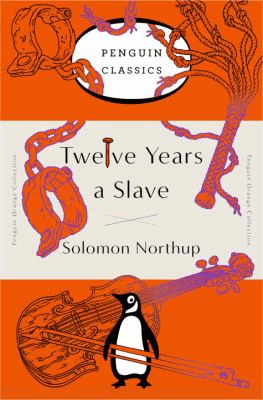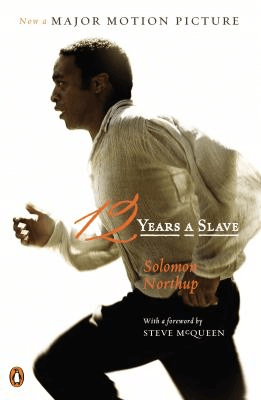Eleventh Stack began publishing content in 2008. That’s nine years of awesome content! We’re highlighting some of our old favorites for Throwback Thursday. The post “Solomon Northup: Keeping the Legacy Alive” was written by Brandon D. and originally appeared on May 28, 2014.
Last year, a patron named Clayton Adams showed me an amazing story that taught me a lot about injustice, resiliency, and hope. It began with trust, followed by deception and injustice, and ends with justice and reunion. And the fact that this story happened at all and that we can go out and read or watch it (I encourage you to do both) is what ultimately gives me hope that we will progress. This story is called Twelve Years a Slave by Solomon Northup.
Northup, a black man born free, was kidnapped from his family in 1841 and sold into slavery in the Deep South. He is threatened into silence by his abductors, being told to never reveal his true identity. For twelve years, Solomon Northup is a Georgia-runaway slave named “Platt” who works for many different owners at different plantations. In 1852, Northup and a Canadian carpenter named Samuel Bass managed to send a letter to Northup’s friends & family in his home state of New York, leading to his freedom on January 3rd, 1853.

Solomon Northup, after regaining his freedom, wasted no time. He wrote and published a memoir called Twelve Years a Slave (1853) detailing his experience. The memoir contains settings and characters also featured in Harriet Beecher Stowe’s Uncle Tom’s Cabin, which was released the previous year. At first, his story took off after 30,000 copies were sold. He went around the North, from city to city, to talk about his experience as a slave. But then in 1857, Solomon disappeared. The location and nature of his death are still unknown. The book also went into obscurity and was not published again until 1968 when Sue Eakin (Louisiana State University at Alexandria) and Joseph Logsdon (University of New Orleans) republished an annotated version.
In 1998, a group of students from Union College set out to learn more about Solomon Northup by tracing his descendants. Based on what they had to go on, tracking any living descendants was next to impossible… until the family of Clayton Adams reached out to Union College and explained their heritage.
Clayton Adams is the great-great-great grandson of Solomon Northup on his mother’s side. He’s also a patron at CLP- West End who first told me about this story. His mother, Carla Adams-Sally, first told him about his family history when he was a junior in high school. At the time, “It just kind of went in one ear and out the other”, Clayton said. It wasn’t until he went to college and took an African American literature class that Clayton began to wonder more about Solomon and his story.

His mother had once owned an original copy of Twelve Years a Slave, given to her by her mother (Clayton’s grandmother), Victoria, along with her other siblings. Victoria’s grandfather was Alonzo Northup, son of Solomon Northup. In 1990, while he was at college, Clayton enrolled in a black literature course. Hearing mention of Solomon’s name and who he was started to pique his interest. He went to his mother with a newfound curiosity and became familiar with a trilogy of slave narratives called Puttin’ on Ole’ Massa featuring stories by Henry Bibbs, William Henry Brown, and Solomon Northup. He then read Twelve Years a Slave.
The film by Steve McQueen (which is available for check-out or request at the Library) is an excellent reenactment of the story. There were “important aspects from the book in the movie that wasn’t held back”, says Clayton. Every scene is faithfully executed with a kind of no-holds-barred approach. “[Steve McQueen] is not trying to sugar coat it, and that’s the thing I like.” What makes the story the most interesting is the situation itself: a black man who was born free gets kidnapped from his family, sold into slavery, and owned by slave owners for twelve years before he proves his freedom. Between these points in the story is a brutally honest portrayal of what life as a slave was like. Clayton thinks “it’s about time that it’s been boldly put into the forefront.”

To this day, Clayton is committed to preserving the story and legacy of his great-great-great grandfather. “We’re still learning,” he says. The whereabouts of Solomon are still unknown and the events leading to and trailing his disappearance are still murky. But so much has already been accomplished in piecing together the life of Solomon Northup. His story almost vanished completely and had been rediscovered and preserved by people who see values and lessons-to-be-learned from these kinds of stories. But why are these stories precious? What do we take away from them? I think Clayton’s mom says it best:
“His courage and perseverance should be an inspiration to all humans who face life’s obstacles and tragedies. We are all proud of him and Anne and hope that others will benefit from knowing his story.”
-Carol Adams-Sally
If you want to know more about Solomon Northup, Twelve Years a Slave, and more, check out the book’s companion website, where you’ll find a blog featuring a post by Clayton Adams, reviews of the book by Harriet Beecher Stowe and Frederick Douglas, and so much more!
–Brandon
Read a harrowing account of kidnapping and slavery
Check out Twelve Years a SlaveBrandon first worked for CLP back in 2010 at the West End branch, working as a page and then as a library clerk. Recently, he began his new job as senior clerk at the Squirrel Hill branch. His favorite book of all time is The Outsiders by S. E. Hinton. He also loves to read autobiographies.

